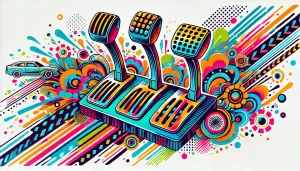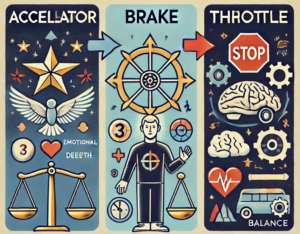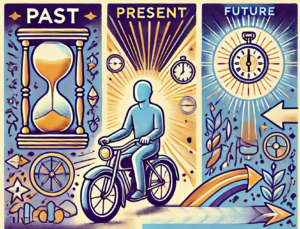 I like this idea from the neuropsychologist Jerome Lubbe about how the Enneagram can be understood through the metaphor of an accelerator/brake/throttle system, which assigns each Enneagram type to one of these elements.
I like this idea from the neuropsychologist Jerome Lubbe about how the Enneagram can be understood through the metaphor of an accelerator/brake/throttle system, which assigns each Enneagram type to one of these elements.
As you may already know, the Enneagram’s intelligence centers—head, heart, and gut—align with our mental, emotional, and physical health respectively, and each type within these centers functions as either an accelerator (driving action), a brake (promoting reflection and withdrawal), or a throttle (modulating and balancing between the two). Each Intelligence Centre holds within it these three energies which manifest as personality styles.
Moving/Doing Centre (Body-based Intelligence)
Type Eight (Accelerator): Eights are driven by a desire for control and action. They push forward with energy and determination, often taking charge and confronting challenges head-on. Here we might say, their egoic accelerator works to assert dominance and influence over their environment, propelling them into action to protect and empower themselves and others. Their need to take immediate and decisive action fuels their constant forward momentum.
Type Nine (Brake): Nines seek peace and harmony, often stepping back to maintain a sense of calm. They embody withdrawal and avoidance of conflict, preferring to keep the peace rather than engage in confrontations. Nines brake because their egoic mechanism favours tranquility and comfort. This withdrawal helps them avoid stress and maintain inner and outer harmony, though it can sometimes lead to inaction and complacency, allowing external pressures to build up without direct confrontation.
Type One (Throttle): Ones strive for balance and perfection, regulating their actions to ensure things are done correctly and ethically. They act as the throttle, constantly adjusting to maintain high standards and improve systems. This throttling action results in a continuous self-regulation process, where they seek to align their behaviour with their moral ideals. This balancing act helps them correct course and improve circumstances, but it can also lead to rigidity and self-criticism as they navigate the tension between their high standards and the imperfections of reality.
Feeling/Relating Centre (Emotion-based Intelligence)
Type Three (Accelerator): Threes are focused on achievement and success. They drive forward with ambition and confidence, constantly striving to reach their goals and attain recognition. Their egoic accelerator propels them towards excellence and validation, pushing them to perform and excel in every endeavour. This drive for success can inspire others but also risks creating a persona overly dependent on external affirmation.
Type Four (Brake): Fours are introspective and emotionally rich, often withdrawing to understand their feelings. They brake because their egoic mechanism draws them inward, seeking depth and authenticity in their emotional experiences. This introspection allows them to connect with their true selves and create meaning, yet it can also lead to a tendency to dwell in their emotions, sometimes causing them to feel isolated and misunderstood.
Type Two (Throttle): Twos balance between helping others and seeking affirmation. They adjust their engagement to offer support while also attending to their own needs for appreciation and connection. Their throttling action involves modulating their altruistic impulses with their desire for reciprocity and love. This balancing act enables them to form deep, caring relationships, though it requires constant attention to their boundaries and self-care.
Thinking/Perceiving Centre (Thought-based Intelligence)
Type Seven (Accelerator): Sevens are driven by enthusiasm and the pursuit of new experiences. Their egoic accelerator fuels their adventurous spirit, pushing them to explore, innovate, and seek joy in every moment. This constant drive for novelty can lead to a vibrant and dynamic life but may also result in difficulty with commitment and follow-through.
Type Five (Brake): Fives withdraw to gather knowledge and understanding. Their egoic brake pulls them into introspection and analysis, seeking to understand the world deeply. This withdrawal allows them to conserve energy and focus on intellectual pursuits, but it can also lead to detachment and isolation from their emotions and relationships.
Type Six (Throttle): Sixes strategize and plan for safety and security. They act as the throttle, constantly adjusting their approach to mitigate risks and ensure stability. Their egoic throttling involves a balance between caution and engagement, allowing them to anticipate potential problems and develop contingency plans. This strategic thinking provides a sense of security but can also lead to anxiety and overthinking.
Correlation with the Autonomic Nervous System

This model also correlates with the autonomic nervous system’s sympathetic (accelerator), parasympathetic (brake), and balance between the two (throttle). The sympathetic response is about activation and mobilization (e.g., fight or flight), preparing the body for immediate action. The parasympathetic response is about rest and digestion, promoting relaxation and recovery; it also includes the freeze or fawn responses, which are related to immobilization and social appeasement behaviours respectively. The balance (throttle) involves regulating between these states for optimal functioning, ensuring the body can respond appropriately to varying demands and maintain homeostasis.
Stress and Growth Paths
 The accelerator/brake/throttle model can also offers valuable insights into stress reactions and growth opportunities for each Enneagram type.
The accelerator/brake/throttle model can also offers valuable insights into stress reactions and growth opportunities for each Enneagram type.
Accelerator types (8, 3, 7) under stress tend to overuse their “gas pedal”:
– Type 8 may become more domineering and confrontational, pushing harder against perceived threats.
– Type 3 might overwork themselves, frantically pursuing achievement at the cost of authenticity and relationships.
– Type 7 could engage in excessive escapism, frantically seeking new experiences to avoid pain or boredom.
For these types, growth often involves learning to apply the “brake” – developing patience, introspection, and the ability to sit with discomfort:
– Type 8 could benefit from cultivating vulnerability and emotional awareness (moving towards Type 2).
– Type 3 might focus on developing authenticity and emotional depth (moving towards Type 4).
– Type 7 could work on developing focus and accepting limitations (moving towards Type 5).
Brake types (5, 9, 4) under stress may overuse their “brake pedal”:
– Type 5 might withdraw completely, becoming isolated and detached from reality.
– Type 9 could become increasingly passive and disengaged, numbing themselves to avoid conflict.
– Type 4 may sink into deep melancholy, over-identifying with their emotions and losing perspective.
Growth for brake types often involves learning to “accelerate” – engaging more actively with the external world:
– Type 5 could benefit from taking more action and engaging with others (moving towards Type 8).
– Type 9 might focus on asserting themselves and pursuing personal goals (moving towards Type 3).
– Type 4 could work on becoming more objective and action-oriented (moving towards Type 1).
Throttle types (1, 2, 6) under stress may lose their balance, alternating between over-acceleration and excessive braking:
– Type 1 might oscillate between rigid perfectionism and harsh self-criticism.
– Type 2 could swing between over-giving and resentful withdrawal.
– Type 6 may alternate between anxious over-planning and paralyzed indecision.
Growth for throttle types involves finding a more nuanced and flexible balance:
– Type 1 could benefit from relaxing their standards and embracing spontaneity (moving towards Type 7).
– Type 2 might focus on recognizing their own needs and setting boundaries (moving towards Type 4).
– Type 6 could work on developing more trust and optimism (moving towards Type 9).
Understanding these stress reactions and growth paths through the accelerator/brake/throttle lens can provide valuable guidance for personal development and therapeutic interventions.
Interplay and Conflict Between Instincts and Types
 We can also map our dominant instincts onto the accelerator, brake, and throttle metaphor. The accelerator mode aligns with the one-on-one/sexual instinct, representing sensory excitation and active engagement. The brake mode corresponds to the self-preservation instinct, reflecting active inhibition and withdrawal. The throttle mode correlates with the social instinct, embodying active regulation and balance.
We can also map our dominant instincts onto the accelerator, brake, and throttle metaphor. The accelerator mode aligns with the one-on-one/sexual instinct, representing sensory excitation and active engagement. The brake mode corresponds to the self-preservation instinct, reflecting active inhibition and withdrawal. The throttle mode correlates with the social instinct, embodying active regulation and balance.
The interplay between a person’s instinct and their Enneagram type can create harmony or conflict within their personality. For example, an individual with a sexual (accelerator) instinct paired with a Type Four (brake) might often experience inner conflict.
The sexual instinct drives them towards intense, passionate engagement and seeking deep connections, pushing them forward. However, as a Type Four, they have a natural tendency towards introspection, emotional depth, and withdrawal to understand their feelings. This can create a push-pull dynamic where the urge to engage deeply with others conflicts with their need to withdraw and process emotions internally.
Similarly, someone with a self-preservation (brake) instinct and a Type Seven (accelerator) might struggle with conflicting desires. The self-preservation instinct urges them to focus on safety, routine, and withdrawing from potentially overwhelming situations. In contrast, Type Seven is driven by the pursuit of new experiences, adventure, and avoiding pain through constant engagement with the world. This could lead to an internal battle between the desire for excitement and the need for security and stability.
What if instincts and type align? An individual with a social (throttle) instinct and a Type Six (throttle) would likely find a more harmonious integration. Both their instinct and type focus on balance, regulation, and maintaining social connections. This alignment helps them strategize effectively, plan for safety, and engage with their community in a balanced manner without significant internal conflict.
Understanding these dynamics allows for a nuanced approach in personal development and therapeutic contexts, recognizing where individuals might face inner conflicts or find natural alignment between their instincts and Enneagram types, as well as with others (friends, partners).
Types and Time Orientation: Harnessing the Power of Past, Present, and Future
 Each of these three types’ responses can also be viewed in terms of their time orientation:
Each of these three types’ responses can also be viewed in terms of their time orientation:
– Brake Types (PAST): Types 5, 9, and 4 reflect on the past, drawing on their experiences and emotions to navigate the present. Understanding their history and context is crucial for these types who often need to process past events to move forward.
– Type 5: Withdraws to gather knowledge and understand past experiences deeply, using this insight to feel secure in the present.
– Type 9: Avoids conflict by retreating into past patterns of peace and harmony, which can sometimes lead to inaction.
– Type 4: Delves into emotional memories to find authenticity and meaning, often revisiting past feelings to connect with their true selves.
– Throttle Types (FUTURE): Types 1, 2, and 6 focus on future planning, constantly adjusting their strategies to find balance and prepare for what lies ahead. They benefit from structured guidance and strategic planning. Like the throttle in a vehicle, they are continually modulating to maintain equilibrium and anticipate future needs.
– Type 1: Strives for perfection and balance, constantly refining their actions to align with their ethical standards and future goals.
– Type 2: Balances helping others with their need for reciprocal relationships, planning how to nurture and maintain connections.
– Type 6: Strategizes for security and stability, preparing for potential risks and creating contingency plans to ensure future safety.
– Accelerator Types (PRESENT): Types 8, 3, and 7 act in the present, driving forward with energy and immediacy. Immediate feedback and action-oriented strategies are effective for them.
– Type 8: Takes charge and asserts control in the moment, using their power to drive immediate change and protect themselves and others.
– Type 3: Pursues achievement and success with a focus on present performance and recognition, continually seeking to excel in the here and now.
– Type 7: Seeks new experiences and adventures, driven by a desire for immediate gratification and the joy of the present moment.
